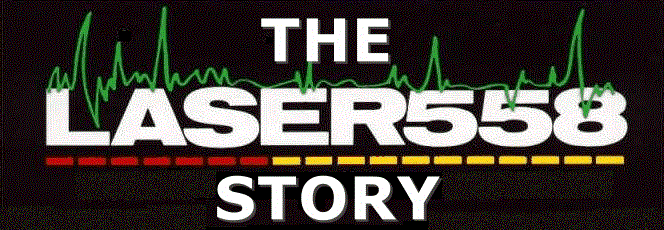Although Philip Smyth appeared to have given up on the Laser project, some of the team did not want to quit. After all their hard work, they were determined to see it through. Paul
Rusling asked a couple of British offshore radio veterans to help. On 4th February 1984 Johnny Lewis and Robin Adcroft joined him on board the Communicator. Lewis had previously broadcast on
Radio Caroline as Stephen Bishop and Adcroft had been an engineer and DJ on both Caroline and Radio Northsea International. With them was Laser DJ/engineer Blake
Williams.
|
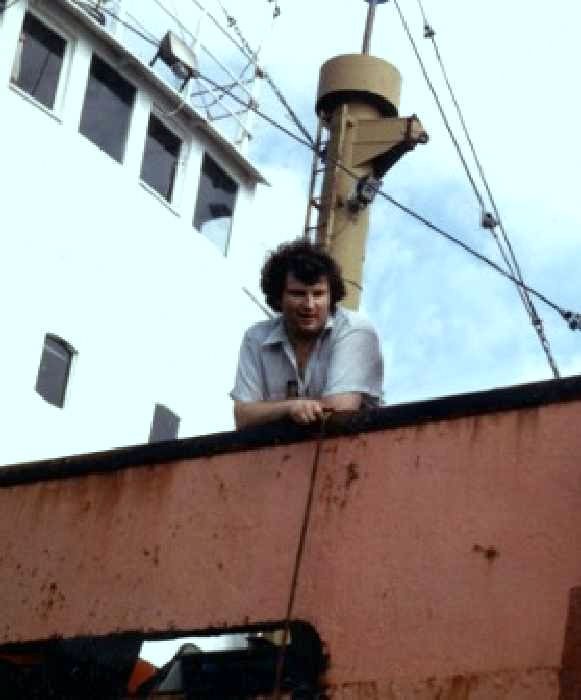
|
|
Johnny Lewis on the mv Communicator. A photo shared by him on Facebook.
|
Some transmitter tests were attempted on 12th February but it was Tuesday 14th before an actual programme was broadcast. After the loss of the two expensive balloons, just a basic T-aerial had been strung between the two low masts.
This meant that the transmitter could only be operated at low power. For the first time some programmes were presented and, although the name of the station was not revealed (apart from once, accidentally, in the middle of the night),
reception reports were requested to be sent to the office of the sales company MMI in New York. Most of the shows were presented by Johnny Lewis and Blake Williams (and very good they were too) but Paul Rusling and the ship's
Captain also helped out on air.
 Blake Williams on a test transmission for Laser on 729kHz, 18th February 1984. The station's name wasn't mentioned during these tests and, to add to the mystery, jingles from a few random American radio stations were played
(duration 4 minutes 17 seconds)
Blake Williams on a test transmission for Laser on 729kHz, 18th February 1984. The station's name wasn't mentioned during these tests and, to add to the mystery, jingles from a few random American radio stations were played
(duration 4 minutes 17 seconds)
The tests continued but the aerial system was very inefficient and, even using low power, it gave off terrifying sparks in all directions. At just after 4pm on 19th February Blake and Johnny closed the
station down, promising to be back within ten days to a fortnight.
 Blake Williams and Johnny Lewis ending the test transmissions on 19th February, slipping in a few Laser blast sound effects over the end of Frankie Goes to Hollywood and saying hello to their neighbours on Caroline. Both this and the
above recording were shared on The Offshore Radio Club Forum by Hans Hendriks. Our thanks to him (duration 7 minutes 22 seconds)
Blake Williams and Johnny Lewis ending the test transmissions on 19th February, slipping in a few Laser blast sound effects over the end of Frankie Goes to Hollywood and saying hello to their neighbours on Caroline. Both this and the
above recording were shared on The Offshore Radio Club Forum by Hans Hendriks. Our thanks to him (duration 7 minutes 22 seconds)
It had been a brave decision to attempt the revolutionary balloon aerial but it had been a total failure. The chosen frequency had also been a mistake but the reaction to the test broadcast was very positive. Over
two thousand letters and reception reports were received. This was enough to convince Philip Smyth to put more money into the project: a further $200,000. Another company, Eurad SA of Panama, was formed by Miami lawyer Glen Kolk to run
Laser. A new aerial mast was ordered and work began on land to construct it. Unfortunately on 16th March the police, accompanied by men from the Department of Trade and Industry, swooped on a yard at Chalk Wharf, Queenborough in Kent.
A number of people were arrested and the Communicator's new mast was confiscated.
In the meantime, at sea, a further test broadcast went out on 4th March. Johnny Lewis had been asked to fire up the transmitter to expel any condensation that might have collected. He decided to go on air for a few hours,
presenting a live show as well as playing a Blake Williams tape. At 7pm Laser-730, still not identified as such, closed down for the last time.
 Johnny Lewis, from his last programme on 729 kHz, 4th March 1974. This clip is taken from a recording shared by www.azanorak.com. Our thanks to Ray Robinson
(duration 3 minutes 35 seconds)
Johnny Lewis, from his last programme on 729 kHz, 4th March 1974. This clip is taken from a recording shared by www.azanorak.com. Our thanks to Ray Robinson
(duration 3 minutes 35 seconds)
The police raid in Queenborough caused concern to some of the American staff. DJs Buzz Cody, Steve Masters and Melinda Clare decided that a pirate's life was not for them. They went home to the States without
presenting a single show. Things were not going at all well for Laser and on 1st April the Communicator suffered yet another set-back when its anchor chain parted. With only four people aboard (Blake, Johnny and two
crew-members) this was potentially disastrous. The supposedly advanced anchor system had proved as successful as the balloon aerial. With a great deal of luck, and not a little skill, disaster was avoided and the emergency anchor
was dropped.
On land the case over the illegal aerial mast came to a Sheerness court on 13th April. The ship's former captain, David Irvine, was fined £500 with £50 costs. This was later quashed because of an error in the wording of
his summons.
Having lost the mast, work now began at sea to erect another aerial system. Over the Easter weekend, in calm sunny weather, two new masts were put up and an aerial strung between them. By the 5th May they were ready. The
following day a signal was put out on a new frequency - 558 kHz, 538 metres. At that time it was just a carrier but on the 7th music started. Initially power was only about 3 kW but it was gradually increased as the
days went on. With a stronger signal and a clear frequency, reception was very good over a wide area. The transmitter was silent from the 9th to 16th May while the new masts were strengthened before the non-stop music resumed.
Then, at 5am on 24th May 1984 with no prior warning, Laser-558 opened for business. The first track was Status Quo's version of Rockin' All Over the World. The British
employees who had worked so hard to get the station on the air left the organisation. It was now all American, on air at least.
 Ric Harris with the opening announcement on Laser-558, 5am on 24th May 1984. This is an edited version of a recording shared on the Radiotrefpunt (radio meeting point) forum by Jan227. Our thanks to him (duration 1 minute 3 seconds)
Ric Harris with the opening announcement on Laser-558, 5am on 24th May 1984. This is an edited version of a recording shared on the Radiotrefpunt (radio meeting point) forum by Jan227. Our thanks to him (duration 1 minute 3 seconds)
 Later on the same show David Lee Stone reads the first news bulletin. This recording courtesy of www.azanorak.com. Our thanks to Ray Robinson (duration 2 minutes 28 seconds)
Later on the same show David Lee Stone reads the first news bulletin. This recording courtesy of www.azanorak.com. Our thanks to Ray Robinson (duration 2 minutes 28 seconds)
For the first few days the disc-jockeys presented five hour shows: 5.00am Ric Harris 10.00 David Lee Stone 3.00pm
Jessie Brandon and 8.00-1.00am someone calling himself Steve Masters. In fact the original Steve Masters had returned to the USA with the other disillusioned jocks
but, in order to capitalise on the promotional material already prepared, a salesman called Dan Crafton took over his name. These four were joined a few days later by Paul Dean, a familiar voice. Back
in the 1970s he had been RNI's Paul May. He had an interesting first day aboard Laser: He arrived on the tender at about 3am on Saturday 26th May. All the ship's occupants were woken up to help unload the boxes of supplies brought out
from shore, including a crate of Moët and Chandon champagne. This had been sent out by Philip Smyth and was intended to celebrate the station opening but it had been delayed by bad weather. With the unloading complete, the DJs
fell on the champagne and, in the warm sun, celebrated their achievement. After much imbibing, Paul was shown round the ship. David Lee Stone was on the air. Fifteen minutes later, Paul wandered back into the studio, to find David Lee
fast asleep, with nothing going out. The champagne and lack of sleep the previous night were having an effect. Paul took over. Jessie Brandon just about managed to read the noon news with obvious difficulty then went off to
bed. When it was time for her show, no one could wake her, so Paul kept going. Jessie finally got to the studio to take over at 6pm.
|
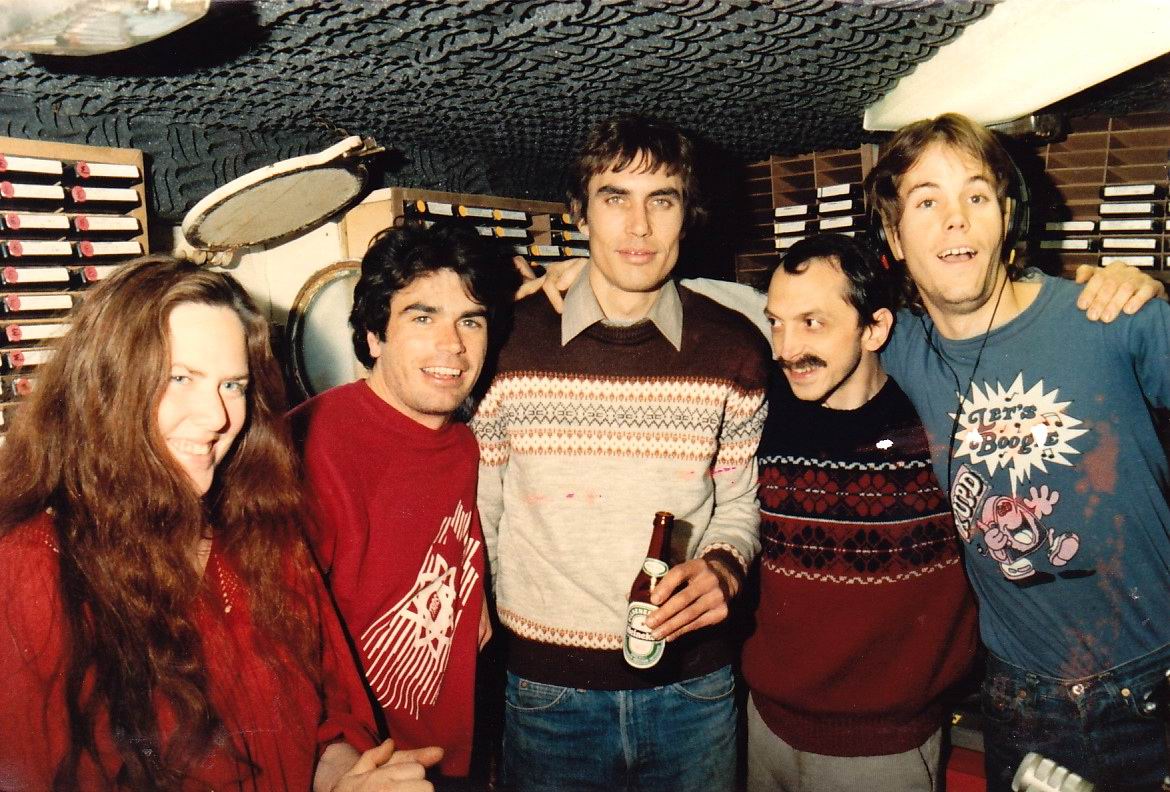
|
|
The first Laser-558 on air team, left to right: Jessie Brandon, Ric Harris, Paul Dean, Steve Masters and David Lee Stone. Photo courtesy of Offshore Echo's
magazine.
|
Laser's format was classic Top 40. A selection of big hits played on rotation, with a good sprinkling of recurrents (recent hits) and oldies with a minimum of chat. Initially the DJs did little more than identify
themselves and their station. Every weekend records from twenty years before were heavily featured on ‘Sixties Sunday’. Laser promised that you were “never more than a minute away from music” and with, as yet,
no adverts and only a short one minute news bulletin on the hour (soon reduced and then abandoned), the music kept on coming. It was a winning formula. The established radio stations, both Radio One and the local independent outlets,
were hobbled by needletime restrictions imposed under pressure from the Musicians' Union. Laser was exciting and played nothing but hits. Despite only word of mouth to promote it, more and more people began to tune to 558.
 David Lee Stone on the first ‘Sixties Sunday’, 27th May 1984. Recording courtesy of Hans Knot (duration 2 minutes 5 seconds)
David Lee Stone on the first ‘Sixties Sunday’, 27th May 1984. Recording courtesy of Hans Knot (duration 2 minutes 5 seconds)
 Jessie Brandon from later that day. This clip taken from a recording shared on www.azanorak.com. Our thanks to Ray Robinson (duration 2 minutes 14 seconds)
Jessie Brandon from later that day. This clip taken from a recording shared on www.azanorak.com. Our thanks to Ray Robinson (duration 2 minutes 14 seconds)
Before the launch the sales team had convinced a major advertising agency to book a campaign on Laser. The agency had written a letter of intent saying that, if the station could establish a regular reliable service, it
would buy airtime promoting a brand of cigarettes (tobacco advertising being banned on the official UK media). Unfortunately Laser was such a huge - and immediate - success that, when the sales team went back to the agency to ask
for confirmation of the booking, the men in suits took fright. They had never expected it to be quite so high-profile. Laser had become a victim of its own success. The advertisers weren't prepared to challenge the Marine Offences Act
so publicly. The deal was called off.
At the end of May the DJs began to advertise various items of Laser paraphernalia - a poster, set of badges, T-shirt, video, etc. - all available from MMI, the sales company in New York. The video, priced at £15, was particularly
poor value. A quarter of an hour long, it had been produced while the Communicator was being fitted out in Florida and featured the original DJ team, half of whom had since left, rushing around the ship while a tune called The
Laser Rap played in the background.
On 1st June, two months after drifting, the Communicator moved back to her original anchorage. With the ship safely secured again, the Laser crew decided it was time to party. Four of them, first mate (later Captain)
Tim Levensaler, crew member Chico and DJs Ric Harris and Paul Dean, set off in a rubber dinghy for the Ross Revenge, the home of Radio Caroline. Unfortunately, when they arrived, they discovered that
their neighbours were off the air with technical difficulties and the DJs and crew were far too busy carrying out repairs to enjoy themselves. The Laser visitors were waved away so they turned round and headed home. Paul Dean
told us: “We came alongside the Communicator to change personnel when the outboard motor packed up. I was holding onto the rope ladder, hanging on for dear life, when Chico slipped against me and knocked the ladder from my
hands. With that the tide took our little boat for a very quick ride. Before we knew it we were swept out of sight of the Communicator. By this time it was getting very cold and the sun had all but gone. We had been adrift for well
over an hour. We could see the Kent coast about 3 miles away.” After a call from the Communicator, an RAF rescue helicopter was launched and, after finding them, called on a fishing boat, the Tarka, to pick up the four worried
passengers and return them to the radio ship.
Steve Masters stayed less than a month but new DJs arrived to join the team. Tommy Rivers and Holly Michaels made their debut on 22nd June, followed eight days later by
Charlie Wolf.
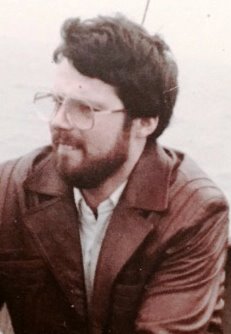
|
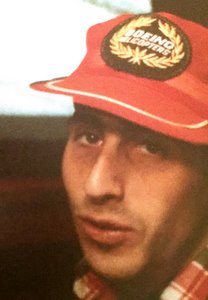
|
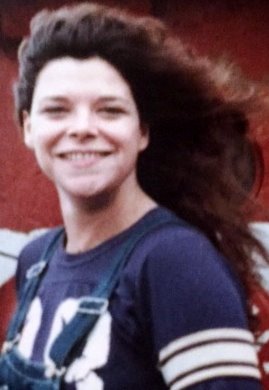
|
|
Tommy Rivers.
|
Charlie Wolf.
|
Holly Michaels.
|
Photos courtesy of Michael Dean. More of his pictures here.
|
 Charlie Wolf on his very first show for Laser, 30th June 1984. This clip taken from a recording shared on The Offshore Radio Club Forum by Hans Hendriks. Our thanks to
him (duration 1 minute 48 seconds)
Charlie Wolf on his very first show for Laser, 30th June 1984. This clip taken from a recording shared on The Offshore Radio Club Forum by Hans Hendriks. Our thanks to
him (duration 1 minute 48 seconds)
 Holly Michaels ends her show and Tommy Rivers starts his, lunchtime on Sunday 9th September 1984. Recording courtesy of Hans Knot (duration 2 minutes 18 seconds)
Holly Michaels ends her show and Tommy Rivers starts his, lunchtime on Sunday 9th September 1984. Recording courtesy of Hans Knot (duration 2 minutes 18 seconds)
Laser-558 was winning new listeners every day but it was not long before the first complaint arrived. 567 kHz, the adjacent channel, was used by Irish station RTE Radio One. Laser did not actually cause
any interference to it in Ireland but it did make reception difficult for those Irish expatriates living in England who wanted to hear the radio from home. The situation was further complicated when Caroline later took over the channel
immediately on the other side of RTE, 576 kHz.
During July the ‘Laser-Lover and Communicator Roadshow’ took to the road for a succession of events all over the south-east of England. Robbie Day and the special guest DJs from the ship pulled in enormous crowds. It was
clear that Laser was attracting a sizeable audience.
|
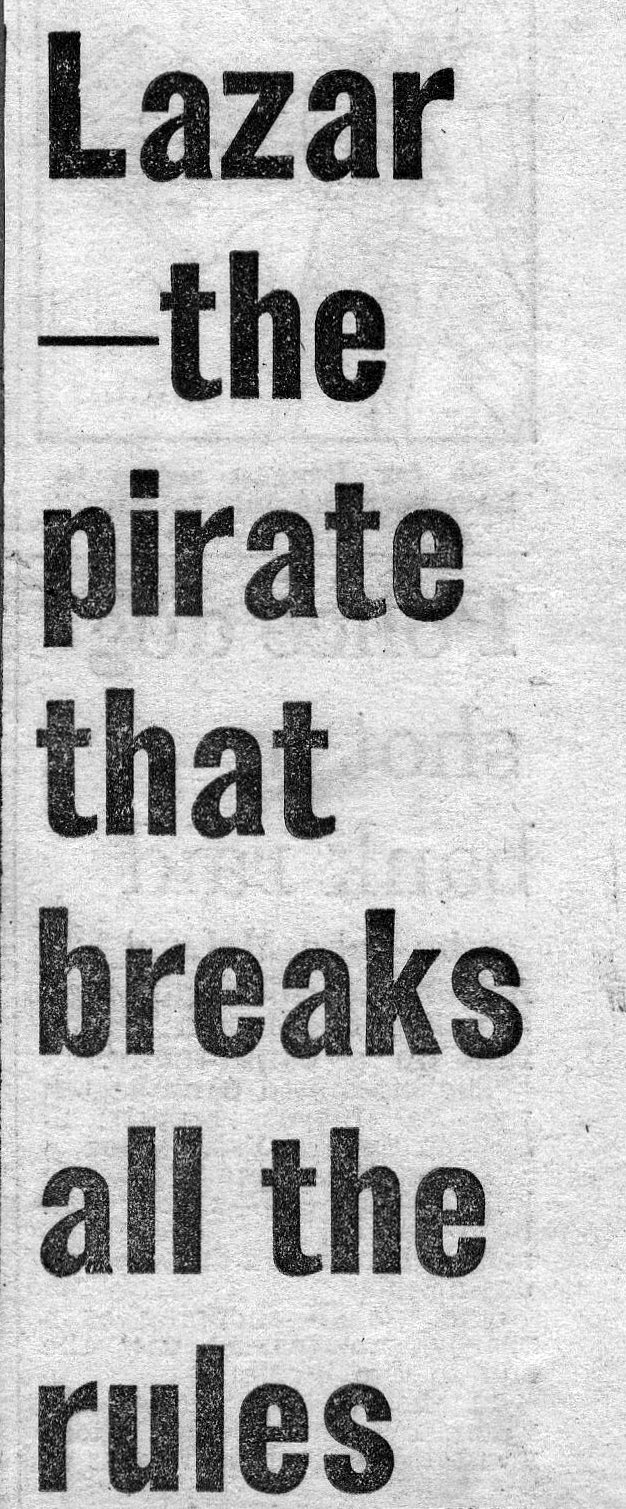
|
|
Headline from the London ‘Evening Standard’, 15th August 1984. The full article is available here.
|
On 1st August there was an emergency on the ship. One of the captains (his name has been reported as Dave Leftwich, Listwich and Litswitch) severed his finger in an accident with a winch. Two crew-members rushed
him ashore in a dinghy to receive medical attention, too late as it turned out: the finger could not be saved. Calling out the emergency services alerted the police but, despite their lack of passports and the threat of the Marine
Offences Act, the crew-members were allowed to return to the Communicator.
Laser's audience was growing as the word spread but British newspapers were remarkably slow to react. It wasn't until 5th August that the Observer printed a generally favourable piece on
life aboard the ship. Ten days later, coincidentally on the 17th anniversary of the Marine Offences Act, the London Evening Standard was less enthusiastic. Under the headline “Lazar (sic) - the pirate that breaks all the
rules”, journalist Jonathan Ashby revealed the ways that the station was contravening various laws: it was being serviced from Britain (against the Marine Offences Act), their American DJs were entering Britain for disco appearances
(immigration laws) and, maybe less seriously, they had bought language classes from the BBC to help make German and French jingles! He also reported that Laser was lifting its news from the BBC-TV's Ceefax service. Despite the fact
that all this was common knowledge to any self-respecting free radio fan, and certainly to the Department of Trade and Industry who monitored the pirates, Ashby's piece was given front page prominence. It was followed a few days
later by another article.
Despite Laser's success very little was known about its background. In August Paul Rusling's book The Lid off Laser was published. No names were mentioned in it but it did reveal that Laser's main backer was not American, as
had been generally believed, but Irish. An advance copy of the book must have landed on the Evening Standard's news desk because, in their article of 21st August, they revealed that the backer was an anonymous Irishman. They
also named a BBC reporter, Roger Parry, as co-ordinator of the Laser project, a claim he denied. On 30th August a further Standard article named the mystery money man for the first time as Philip Smyth. (Copies of these and other
articles are here and following pages.)
| SOME 1984 LASER-558 PROGRAMME SCHEDULES |
| 27th May - 16th June 1984 |
? July - 5th August 1984 |
28th August - 2nd September 1984 |
5.00am Ric Harris
9.00 David Lee Stone
1.00pm Paul Dean
5.00 Jessie Brandon
9.00 Steve Masters
1.00am closedown
|
5.00am David Lee Stone
9.00 Holly Michaels
1.00pm Tommy Rivers
5.00 Jessie Brandon
9.00 Charlie Wolf
1.00am closedown
|
5.00am Ric Harris
10.00 Holly Michaels
3.00pm Jessie Brandon
8.00 Charlie Wolf
1.00am closedown
|
From Friday 7th September Laser-558 broadcast for an extra hour on Friday and Saturday nights, closing at 2am. This extra hour, initially presented by Charlie Wolf, later became an extravaganza called variously
“The Mariners Hour”, “The Zany Hour” or “The Not Ready For Prime Time Broadcasters Hour”. It was hosted by various DJs, crew-members and engineers including Captain Tim Levensaler, engineers
Mighty Joe Young and Chris Allan, ship's steward Michael Dean and deckhand Shawn O'Neil. The last of
these programmes were heard over the weekend of 17th - 18th November.
 Charlie Wolf is joined by Chris Allan on a Saturday night Zany Hour in late 1984. Recording kindly provided by Hans Knot (duration 4 minutes 8 seconds)
Charlie Wolf is joined by Chris Allan on a Saturday night Zany Hour in late 1984. Recording kindly provided by Hans Knot (duration 4 minutes 8 seconds)
Many thanks to Radio Adventures of the mv Communicator and The Lid Off Laser 558, both by Paul Rusling, Laser 558: All Europe Radio by Hans Knot, Monitor magazine and
Offshore Echos.
Press cuttings from 1983-4 here and following pages.
Back to part one.
Part three over the page.
|

